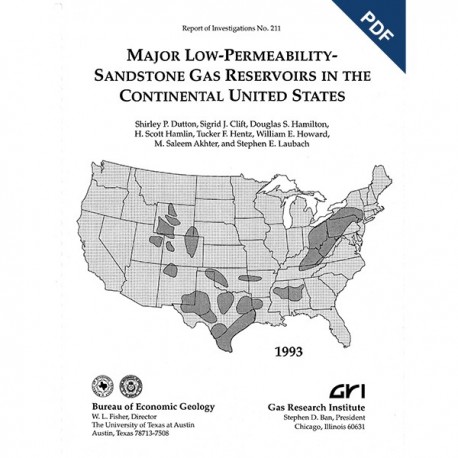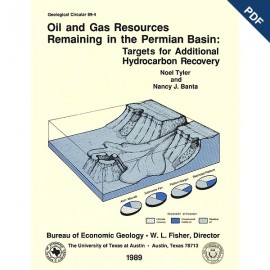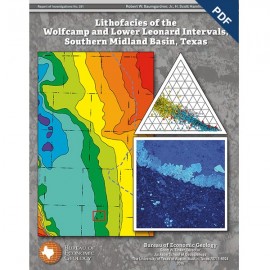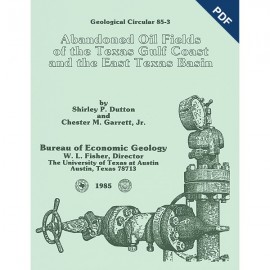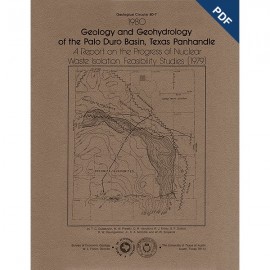Reports of Investigations
-
Books & Reports
- Reports of Investigations
- Guidebooks
- Udden Series
- Geological Circulars
- Down To Earth
- Atlases of Major Oil and Gas Reservoirs
- Texas Memorial Museum Publications
- Environmental Geologic Atlas of the Texas Coastal Zone
- Mineral Resource Circulars
- Other Reports
- Seminars and Workshops
- Handbooks
- Submerged Lands of Texas
- Symposia
- Annual Reports
- Open File Reports
-
Maps & Cross Sections
- Thematic Maps
- Miscellaneous Maps, Charts & Sections
- Geologic Atlas of Texas
- STATEMAP Project Maps
- Geologic Quadrangle Maps
- Cross Sections
- Highway Geology Map
- Energy and Mineral Resource Maps
- Shoreline Change and Other Posters
- Wilcox Group, East Texas, Geological / Hydrological Folios
- Bouguer Gravity Atlas of Texas
- River Basin Regional Studies
- Featured Maps
- Posters
- Teachers & the Public
-
Geological Society Publications
- Gulf Coast Association of Geological Societies
- Alabama Geological Society
- Austin Geological Society
- Corpus Christi Geological Society
- Houston Geological Society
- Lafayette Geological Society
- Mississippi Geological Society
- New Orleans Geological Society
- South Texas Geological Society
- GCS SEPM Publications
- Historic BEG & UT Series
Major Low-Permeability-Sandstone Gas Reservoirs in the Continental United States. Digital Download
RI0211D
For a print version: RI0211.
RI0211D. Major Low-Permeability-Sandstone Gas Reservoirs in the Continental United States, by S. P. Dutton, S. J., Clift D. S. Hamilton, H. S. Hamlin, T. F. Hentz, W. E. Howard, M. S. Akhter, and S. E. Laubach. 221 p., 171 figs., 33 tables, 1993. doi.org/10.23867/RI0211D. Downloadable PDF.
To purchase this publication in book format, please order RI0211.
About This Publication
This report summarizes geologic, engineering, and production information on 24 low-permeability, gas-bearing sandstone reservoirs in 13 basins in the United States. The information compiled in this report comes from publicly available sources: Gas Research Institute and Department of Energy project reports, applications by gas producers to state regulatory agencies for tight formation designation, and published literature. The formations included in this volume were selected because they contain abundant natural gas resources or because detailed information is known about them that is applicable to other, similar formations. Assessment of these sandstone reservoirs indicates that geological controls play a critical role in gas producibility and that many of these reservoirs share a number of key geological attributes.
As it does in conventional oil and gas fields, reservoir genesis clearly influences gas accumulation and recovery in tight gas fields. The major tight gas sandstone reservoirs surveyed herein were deposited in 10 barrier/strandplain and 7 deltaic depositional systems. Four fluvial, three shelf, and one slope and basin, and fan-delta depositional system make up the remainder. Production characteristics of low-permeability gas reservoirs are, however, in large part controlled by the diagenesis of the sediment. In these 24 formations, authigenic quartz and clays have the greatest effect on reducing permeability, quartz by occluding intergranular pores and clays by increasing water saturation because of their high surface-to-volume ratio. Calcite cement destroys porosity and permeability in particular beds or layers in some formations, but its distribution is not as uniform or widespread as that of quartz cement.
Natural fractures are common features of tight gas sandstones, but because most are vertical extension fractures that are easily missed by vertical cores, detailed information on natural fracture attributes is rarely available. Fractures can enhance production, and in some formations they need to be taken into account in drilling, completion, and stimulation design. Information on stress directions and stress contrasts in low-permeability sandstone reservoirs is also important for designing engineering operations in these rocks. Available data on natural fractures, stress directions, and stress-magnitude contrasts are summarized for each formation.
Twenty-one of the 24 low-permeability formations discussed in this volume have produced 22.3 Tcf of gas through 1988; this figure does not include production from the "Clinton"-Medina and Berea Sandstones in the Appalachian Basin or the Davis sandstone in the Fort Worth Basin. Estimated ultimate recovery from existing wells in the 21 formations for which compiled production data are available is 47.1 Tcf.
Keywords: hydraulic-fracture treatment, maximum horizontal stress, natural fractures, natural gas resources, production history, reservoir engineering, reservoir quality, stratigraphy, tight gas sandstones
CONTENTS
Abstract
Introduction
Data Sources
Production Data
Selection of Formations
Report Structure
Geologic Controls on Tight Gas Sandstone Productivity
Stratigraphy and Depositional Systems
Reservoir Composition and Diagenesis
Petrographic Analysis
Diagenetic Types of Low-Permeability Sandstones
Clay Minerals
Natural Fractures in Low-Permeability Sandstone
Incidence of Natural Fractures in Tight Gas Sandstones
Implications of Natural Fractures for Efficient Gas Production
Anticipating Natural Fracture Attributes
Stress Directions and Stress Contrasts
Stress Directions
Stress Contrasts
Engineering Characteristics of Tight Gas Sandstones
Capillary Pressure Formation Evaluation in Tight Gas Sandstones
Appalachian Basin
"Clinton" -Medina Sandstone
Introduction Depositional Systems and Reservoir Facies
Composition of Reservoir Facies
Natural Fractures
Engineering Characteristics
Production History
Berea Sandstone
Introduction
Depositional Systems and Reservoir Facies
Composition of Reservoir Facies
Natural Fractures
Engineering Characteristics
Production History
East Texas and North Louisiana Basins
Cotton Valley Sandstone
Introduction
Depositional Systems and Reservoir Facies
Composition of Reservoir Facies
Natural Fractures
Stress
Engineering Characteristics
Production History
Travis Peak Formation
Introduction
Depositional Systems and Reservoir Facies
Composition of Reservoir Facies
Natural Fractures
Stress
Engineering Characteristics
Production History
Maverick Basin
Olmos Formation
Introduction
.Depositional Systems and Reservoir Facies
Catarina Delta System
Rocky Creek Barrier/Strandplain System
Olmos "A" and "B” Sandstones
Composition of Reservoir Facies
Natural Fractures
Engineering Characteristics
Production History
Texas Gulf Coast Basin
Wilcox Group
Introduction
Depositional Systems and Reservoir Facies
Composition of Reservoir Facies
Natural Fractures
Engineering Characteristics
Production History
Vicksburg Formation
Introduction
Depositional Systems and Reservoir Facies
Composition of Reservoir Facies
Natural Fractures
Stress
Engineering Characteristics
Production History
Fort Worth Basin
Davis Sandstone
Introduction
Depositional Systems and Reservoir Facies
Composition of Reservoir Facies
Natural Fractures
Engineering Characteristics
Production History
Anadarko Basin
Granite Wash
Introduction
Depositional Systems and Reservoir Facies
Composition of Reservoir Facies
Natural Fractures
Engineering Characteristics
Production History
Cherokee Group (Red Fork Formation)
Introduction
Depositional Systems and Reservoir Facies
Composition of Reservoir Facies
Natural Fractures
Stress
Engineering Characteristics
Production History
Cleveland Formation
Introduction
Depositional Systems and Reservoir Facies
Composition of Reservoir Facies
Natural Fractures
Engineering Characteristics
Production History
Permian Basin
Morrow Formation
Introduction
Depositional Systems and Reservoir Facies
Composition of Reservoir Facies
Natural Fractures
Engineering Characteristics
Production History
Abo Formation
Introduction
Depositional Systems and Reservoir Facies
Composition of Reservoir Facies
Natural Fractures
Engineering Characteristics
Production History
Val Verde Basin
Canyon Sandstone
Introduction
Depositional Systems and Reservoir Facies
Composition of Reservoir Facies
Natural Fractures
Engineering Characteristics
Production History
San Juan Basin
Dakota Sandstone
Introduction
Depositional Systems and Reservoir Facies
Composition of Reservoir Facies
Natural Fractures
Engineering Characteristics
Production History
Mesaverde Group and the Chacra Formation
Introduction
Depositional Systems and Reservoir Facies
Point Lookout Sandstone
Cliff House Sandstone
Chacra Formation
Composition of Reservoir Facies
Point Lookout Sandstone
Cliff House Sandstone
Chacra Formation
Natural Fractures
Engineering Characteristics
Production History
Pictured Cliffs Sandstone
Introduction
Depositional Systems and Reservoir Facies
Composition of Reservoir Facies
Natural Fractures
Engineering Characteristics
Production History
Denver Basin
J Sandstone
Introduction
Depositional Systems and Reservoir Facies
Composition of Reservoir Facies
Natural Fractures
Engineering Characteristics
Production History
Piceance Basin
Introduction
Dakota Sandstone
Introduction
Depositional Systems and Reservoir Facies
Composition of Reservoir Facies
Natural Fractures
Engineering Characteristics
Production History
Mancos "B" Shale
Introduction
Depositional Systems and Reservoir Facies
Composition of Reservoir Facies
Natural Fractures
Engineering Characteristics
Production History
Mesaverde Group
Introduction
Depositional Systems and Reservoir Facies
Corcoran and Cozzette Sandstones
Rollins Sandstone
Undifferentiated Williams Fork Sandstones
Composition of Reservoir Facies
Corcoran and Cozzette Sandstones
Rollins Sandstone
Undifferentiated Williams Fork Sandstones
Natural Fractures
Engineering Characteristics
Production History
Green River Basin
Frontier Formation
Introduction
Depositional Systems and Reservoir Facies
Composition of Reservoir Facies
Natural Fractures
Stress Information
Engineering Characteristics
Production History
Upper Almond and Blair Formations
Introduction
Depositional Systems and Reservoir Facies
Blair Formation
Almond Formation
Composition of Reservoir Facies
Natural Fractures
Engineering Characteristics
Production History
Wind River Basin
Frontier Formation
Introduction
Depositional Systems and Reservoir Facies
Composition of Reservoir Eacies
Natural Fractures Engineering Characteristics
Production History
Acknowledgments
References
171 Figures
33 Tables
Citation
Dutton, S. P., Clift, S. J., Hamilton, D. S., Hamlin, H. S., Hentz, T. F., Howard, W. E., Akhter, M. S., and Laubach, S. E., 1993, Major Low-Permeability-Sandstone Gas Reservoirs in the Continental United States: The University of Texas at Austin, Bureau of Economic Geology, Report of Investigations No. 211, 221 p. doi.org/10.23687/RI0211D.
